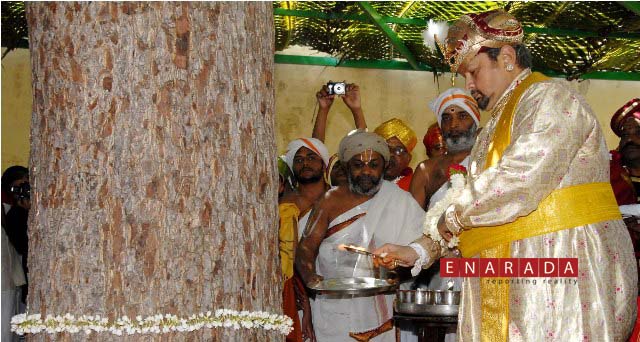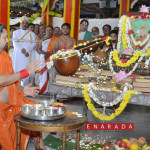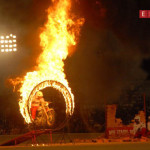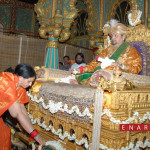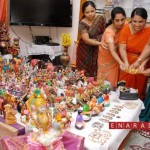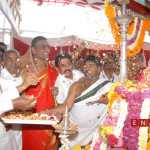ENARADA, Mysore, October 14, 2013:
The Mysore Dasara Festivities by the Wadiyar Royal Family ended with performing of ‘shammi pooja’ at the Bhuvenswari Temple inside the palace court yard .
The scion of the Mysore royal family, Srikantadatta Narasimharaja Wadiyar, attired in his royal robes, came in in the procession and returned to the palace after prayers at the temple in the marking the end of Dasara celebrations.
Normally, on the last day of Dasara festivities, Mr.Wadiyar used to ride a silver cart drawn by caparisoned bulls during procession to temple and back to palace, but this year he came in a car.
Wadiyar family members and royal family Priests, participated in the procession of elephants, horses, Camel and other traditional weapons.
Mr Wadiyar entred the temple with a royal sword and placed it near the ‘shammi’ tree before offering pooja to the tree.
Prior to this programme Mr Wadiyar witnessed the famed ‘varja musti kalaga’ the traditional form of wrestling which was performed by the three pairs. However, this was only traditional wresting which has been continued by the royal family members.
Later he returned to the palace, worshiped the family deity goddess Chamundeswari and completes the religious observance.
The initial nine days also saw the private durbar of the Mysore royal family held to commemorate Dasara festivities, the genesis of which is traced to the celebrations observed by the Vijayanagar emperors in Hampi.
The baton was passed to the Wadiyars who kept alive the tradition with customary rituals adding a dash of colour with the caparisoned elephants, horses, and soldiers participating in a procession.
In the past, the Maharaja used to ascend the royal throne on all the nine days and hold a durbar while the subjects used to pay their obeisance to the ruler.
The royal durbar, which caught the fancy of the public, surpassed all other aspects of the Navaratri festival, and the customary tradition continued despite the end of the monarchy.

